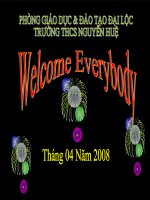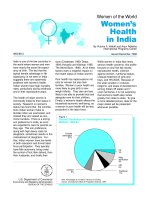- Trang chủ >>
- Khoa Học Tự Nhiên >>
- Vật lý
Rivers of the world
Bạn đang xem bản rút gọn của tài liệu. Xem và tải ngay bản đầy đủ của tài liệu tại đây (4.27 MB, 382 trang )
RIVERS
OF THE
WORLD
A SOCIAL,
GEOGRAPHICAL,
AND ENVIRONMENTAL
SOURCEBOOK
RIVERS
OF THE
WORLD
A SOCIAL,
GEOGRAPHICAL,
AND ENVIRONMENTAL
SOURCEBOOK
James R. Penn
Santa Barbara, California—Denver, Colorado—Oxford, England
© 2001 by James R. Penn
All rights reserved. No part of this publication may be reproduced, stored in a retrieval system,
or transmitted, in any form or by any means, electronic, mechanical, photocopying, recording,
or otherwise, except for the inclusion of brief quotations in a review, without prior permission
in writing from the publishers.
Library of Congress Cataloging-in-Publication Data
Penn, James R.
Rivers of the world : a social, geographical, and environmental
sourcebook / James R. Penn.
p. cm.
Includes bibliographical references and index (p. ).
ISBN 1-57607-042-5 (hardcover : alk. paper) — 1-57607-579-6 (ebook)
1. Rivers—Encyclopedias. I. Title.
GB1201.4 .P46 2001
910'.91693—dc21
2001004556
06 05 04 03 02 01—10 9 8 7 6 5 4 3 2 1
This book is also available on the World Wide Web as an ebook. Visit abc-clio.com for details.
ABC-CLIO, Inc.
130 Cremona Drive, P.O. Box 1911
Santa Barbara, California 93116–1911
This book is printed on acid-free paper.
Manufactured in the United States of America
For Laura
You cannot step into the same river twice.
Heraclitus
Rivers are more than hydrology; they have lives and souls...
Louise Wagenknecht
CONTENTS
Preface, xiii
Introduction, xv
Maps, xvii
RIVERS OF THE WORLD:
A SOCIAL, GEOGRAPHICAL, AND ENVIRONMENTAL SOURCEBOOK
Aare, 1
Achelous, 2
Adda, 3
Adige, 4
Adonis, 5
Alpheus, 6
Amazon, 7
Amu Darya, 9
Amur, 11
Angara, 13
Aras, 15
Arno, 15
Assiniboine, 18
Atbara, 19
Atchafalaya, 19
Brahmaputra, 30
Bug, Western, 31
Balsas, 23
Beas, 23
Beni, 25
Benue, 25
Big Sioux, 26
Blue Nile, 27
Boyne, 29
Dal, 57
Danube, 58
Darling, 61
Dee, 63
Delaware, 63
Dnieper, 65
Dniester, 67
Casiquiare, 33
Chambal, 34
Chao Phraya, 35
Chari, 37
Chenab, 37
Churchill, 38
Clyde, 39
Colorado, 41
Columbia, 44
Colville, 48
Congo, 50
Connecticut, 53
ix
x
CONTENTS
Don, 68
Dordogne, 70
Douro, 72
Drava, 73
Liffey, 136
Limpopo, 137
Loire, 138
Gambia, 87
Ganges, 88
Garonne, 90
Gila, 92
Glomma, 93
Green, 94
Guadalquivir, 95
Mackenzie, 143
Madeira, 144
Magdalena, 145
Mahaweli Ganga, 146
Maritsa, 147
Marne, 148
Medway, 149
Mekong, 150
Menderes, 152
Meuse, 154
Mississippi, 155
Missouri, 158
Mohawk, 161
Morava, 163
Moselle, 164
Murray, 165
Murrumbidgee, 167
Hadhramaut, 99
Hooghly, 100
Huang He (Yellow), 102
Hudson, 105
Humber, 107
Humboldt, 108
Narmada, 169
Negro, 170
Niagara, 170
Niger, 173
Nile, 176
Northern Dvina, 179
Illinois, 111
Indus, 113
Irrawaddy, 115
Irtysh, 117
Ob’, 181
Odra, 183
Ogooué, 184
Ohio, 185
Oka, 187
Okavango, 188
Omo, 189
Orange, 190
Orinoco, 191
Orontes, 193
Ottawa, 194
Earn, 75
Ebro, 75
Elbe, 77
Essequibo, 79
Euphrates, 80
Forth, 83
Fraser, 84
James, 119
Jhelum, 122
Jordan, 122
Kabul, 125
Kennebec, 126
Kizil Irmak, 127
Klarälven, 128
Krishna, 129
La Paz, 133
Lena, 134
Paraguay, 197
Paraná, 198
Paranaíba, 200
Peace, 201
Penobscot, 202
CONTENTS
Plata, 204
Platte, 205
Po, 206
Potomac, 209
Pripet, 211
Stikine, 267
Susquehanna, 268
Sutlej, 271
Swan, 272
Syr Darya, 274
Ravi, 213
Red (China), 214
Red (of the North), 215
Red (of the South), 216
Rhine, 218
Rhône, 221
Rhumel, 224
Rio Grande, 224
Rubicon, 227
Ruhr, 229
Tagus, 277
Tarim, 278
Tay, 279
Tennessee, 280
Thames, 282
Tiber, 285
Tigris, 286
Trent, 287
Tweed, 288
Saar, 231
Sacramento, 232
Saint Lawrence, 235
Salt, 238
Salween, 239
Sambre, 241
San Joaquin, 242
San Juan, 245
São Francisco, 246
Saône, 247
Saskatchewan, 248
Savannah, 249
Scheldt, 251
Seine, 252
Sénégal, 254
Severn, 255
Shannon, 256
Shatt al Arab, 257
Shenandoah, 259
Snake, 261
Somme, 264
Songhua Jiang, 266
Vaal, 291
Vardar, 292
Vistula, 293
Volga, 294
Wei, 297
Weser, 298
Western Dvina, 298
White Nile, 299
Willamette, 301
Wisconsin, 303
Xi He, 307
Yalu, 311
Yamuna, 312
Yangtze, 313
Yenisey, 315
Yukon, 316
Zambezi, 319
Ziz, 321
Glossary of River Terms, 323
Bibliography, 331
Index, 339
About the Author, 357
xi
xii
PREFACE
who was zipping by on the fast-track Internet and
eluding the print-bound coyote. The publisher of
this book, ABC-CLIO, has been at the forefront of
innovations in reference books with its Historical
Abstracts series and interesting thematic reference
volumes, and this book is being offered as either a
hardcover book or an ebook.
This volume is a comprehensive treatment of
the major rivers of the world in their physical,
cultural, and environmental settings. All of the
great rivers of the world—the Nile, Niger, Amazon,
Mississippi, Yangtze, and many others—are
included here, as well as many lesser rivers, including some comparatively small waterways that illustrate important themes or represent significant
trends. This raises the question: What were my
criteria for selecting rivers to include in this
volume? I must confess to a certain amount of
arbitrariness, but I tried to consider the size of the
river and its drainage basin, the frequency with
which the river was referred to in historical
accounts, and the role it plays in the increasingly
decisive relationship to human activities in the
present. For practical reasons I operated within the
constraint that I didn’t want the number of entries
to exceed about 200. To write as complete an
account as I wanted to, and to give each river an
individual description with a personal style rather
than writing in the monochromatic style of, say, a
dictionary, I needed to keep my entry list within
bounds. Without such limits it would have taken
Reference works arranged in alphabetical order
have been a staple of the book business for some
two and a half centuries, ever since a group of
French philosophes had the audacity to try to
encompass all of human understanding within the
bindings of volumes they chose to call encyclopedias. The name stuck, and more importantly the
idea, including the Enlightenment belief that the
widely disseminated printed word had a progressive power and shaping influence in the world.
Although many would consider the idea to treat all
of human knowledge in a single set of reference
works to have reached its physical limitations with
the publication of the 11th edition of the
Encyclopedia Britannica (1911), the usefulness and
commercial viability of the treatment of specific
topics, of which this book is an example, have been
demonstrated over and over again.
No one can read the future, of course, but the
use of the Internet for research and the reading of
books made available as digital files or printed on
demand at individually controlled sites are significant trends that will inevitably affect the course of
book publishing. As I was writing this book, I
happened to read a provocative review of a new
reference book on the American West that
acknowledged the excellence of the volume but at
the same time questioned its need in a digital age,
comparing the editor and authors to absurd Wile
E. Coyotes in the Roadrunner cartoon series,
forever missing the electronically fast desert bird
xiii
xiv
PREFACE
even a team of writers and editors at a large press
many years to complete this project in a reasonable
period of time. As it is, the research, writing, and
editing of this work required about three years of
my time and proved every bit as daunting as my
first book. In short, I included all of the great rivers
of the world and then added rivers that were of
particular significance for cultural, historical, or
environmental reasons, all within the constraints of
not exceeding 200 entries.
The famous nineteenth-century French writer
Jules Verne once read an account of his life and
work that was written late in his career. He noted
that the Italian critic Mario Turiello had failed
to comprehend Verne’s purpose, which the
Frenchman felt had been “the teaching of geography, the description of the earth. For each new
country I had to invent a new story. The characters
are only secondary, whatever you may think.” At
the risk of being overly subtle and exposing myself
to the charge of comparing my abilities to those of
Verne, I am tempted to say that my purpose isn’t
so much the recounting of a large quantity of
geographical information as the telling of a story
or at least opening up numerous anecdotal lines. If
the author of such popular novels as Journey to the
Center of the Earth and Around the World in Eighty
Days wanted to teach themes about the earth’s
regions through his spellbinding tales, I am trying
here to make use of the materials of substantive
research and expository prose (no one would call
this a work of anything but nonfiction) to offer
glimpses of historical drama, poetic significance,
and cultural relationship. Though at times
wearing the trappings of a scientist, I had too
many good courses in literature and history as a
student at the University of Wisconsin to be able to
dissociate myself from an essentially humanist
core. Each day I live, read, and think, I hope to add
integuments to the thought and work of Erasmus,
Montaigne, and Shakespeare.
This book is no substitute for a good atlas, that
most essential reference work, which I recommend
each reader have at hand while perusing this
volume. An atlas will indicate the location of the
myriad streams, towns, and other places referred to
in the text beyond the ones shown on my few
maps, and show other relevant locational and situational material that the text doesn’t treat.
It is always a pleasure to acknowledge the
numerous debts incurred in the writing of a book. I
would first like to thank Alicia Merritt at ABCCLIO, who was much more than my acquisition
editor; she was the one who originally suggested the
idea for this book and frequently offered encouragement along the way. Dr. H. Jesse Walker, Boyd
Professor of Geography at Louisiana State
University, generously contributed a number of
excellent photos to illustrate this book, as he did my
first. Jesse influenced the text of the book as well,
especially in matters concerning coastal processes in
deltas. I am grateful to Jesse for showing me articles
and reprints based on his long and productive
career as a coastal geomorphologist with a special
interest in the Arctic. I am glad to acknowledge two
colleagues of mine going back to graduate school
days, Pascal Girot and Kent Mathewson, who
contributed information that was useful in writing
the entries respectively on the San Juan on the
border between Costa Rica and Nicaragua and the
Casiquiare in northern South America. I would like
to thank Martin Hanft for his deft editing of the
manuscript to tease out my sometimes obscure
meanings. By researching the image archives, Chava
Boylan added some excellent photos and prints to
illustrate the text. At ABC-CLIO, Carol Smith
handled production, and Liz Kincaid coordinated
the artwork and secured permissions. Finally, I owe
a debt of gratitude to my wife, Laura, who not only
provided the kinds of emotional and personal
support required of a spouse during such a long
undertaking but also drew the figures and
contributed some of her own photos.
INTRODUCTION
decided to make this material available in a glossary. Where appropriate, I have integrated these
concepts into the text, and the reader can refer to
the glossary if he or she wants additional elaboration. For example, if an entry on a river with a
major falls or rapids (for example, Niagara) refers
to such a technical concept as knickpoint, which I
will usually briefly define in the text as an aid to
comprehension, the reader can consult the glossary for a fuller discussion of the term, perhaps
also looking at a related term such as longitudinal
profile. I would recommend that the reader peruse
the glossary at least in a cursory way before
reading the book, as this would give the fullest
understanding of individual rivers in relationship
to geomorphic processes. Some of the key terms
and concepts that I had planned to elucidate here,
but put instead into the glossary, include floodplain, meander, delta, estuary, river network, and
drainage pattern.
For North American rivers I can happily refer
the reader to an excellent series of books written by
some of America’s most gifted writers during the
last generation or two. The Rivers of America Series
published by Farrar and Rinehart (under various
corporate names) between 1937 and 1974 represented a major effort to get popular and authoritative authors to write vivid, readable, and comprehensive accounts of America’s primary waterways.
A total of sixty-four books on individual rivers (and
one songbook) eventually appeared in this award-
Rivers don’t really begin or end. Hydrographers
can’t identify a single source in the highly fissured
Alpine glacier where the Rhine begins any more
than they can pinpoint the precise location where
western Europe’s greatest river slows and separates
into a number of branches as it crosses the Low
Countries en route to the North Sea. Which particular rivulet, seep, or puddle in the environs of Lake
Itasca in north-central Minnesota is the source of
the Mississippi? If you travel south from New
Orleans, no one can tell which of the many
branches of the Birdfoot delta, the current outlet of
the river, is the real mouth of the Mississippi.
It’s not just a question of “Who cares?” (a lot of
people do), but a question of the continuity of a
hydraulic system. A river is but one segment of the
water cycle—from the evaporation of water over a
broad ocean, to the drifting of a cloud over a continent, to precipitation being gathered in countless
rivulets to form a regular channel (some goes to
recharge groundwater). By a devious course the
channelized flow of a river eventually reaches the
sea, where the cycle begins anew. There is yet
another sense in which a river doesn’t begin or end.
We don’t need the Victorian poet laureate to tell us
that though we die and pass away, Philip’s Brook, in
Tennyson’s words, goes on forever.
I considered providing a short course in this
introduction to certain themes and concepts in
geomorphology—the science of river forms and
processes—but found it too cumbersome and so
xv
xvi
INTRODUCTION
winning series. Noted authors included Carl
Carmer (the Hudson), Edgar Lee Masters (the
Sangamon), Hodding Carter (the lower Mississippi), August Derleth (the Wisconsin) among
others, and original illustrations were contributed
by the likes of Andrew Wyeth and Lynd Ward. For
the rivers covered here that were included in the
series I have listed references in the Further Reading
sections and in the bibliography. I am not aware of
any authoritative listing of these popular books,
although clean copies with dust jackets intact are
much in demand by book collectors.
This encyclopedia consists of 192 alphabetically
arranged entries ranging from 250 words to 2,100
words. It has been my aim to make the contents of
the entries as thoroughly researched, vividly
written, and clearly organized as possible. I
attempted to provide a comprehensive treatment
of the rivers of the world—large and small—from
the River Aare in Switzerland to Africa’s Ziz, with
an eye toward revealing the physical, economical,
political, and environmental character of the
world’s alluvial landscapes and regions.
Each entry begins with key information on the
source of the river, its length, major tributaries,
and outlet for quick reference. Within this key
information readers will find boldface cross-
references for rivers that have their own entries.
Most entries contain references at the end for
further reading. A complete bibliography of works
consulted can be found at the back of the book. See
also references at the end of entries are used to
refer the reader to other relevant portions of the
book. For the nagging problem of multiple and
changing names, cross-references will help guide
the reader to the appropriate entry (for example,
Yellow River—See Huang He). I have included a
selection of quotations to open another window
on the world of rivers. Though rivers in North
America and Europe do not receive short shrift in
this work, I think that my more-or-less complete
treatment of rivers in other parts of the world is
one of this volume’s primary contributions. Also,
environmental and land use problems of flooding,
pollution, and river regulation have not received
such broad coverage before.
Let me send the reader off with an original
riddle. Can you detect the four rivers referred to,
however indirectly, in the following lines (all four
are covered in this book)? By the waters of the
somber river I babble on and muse. Bon voyage!
(Answer: somber = Sambre; babble on =
Babylon, thus the Tigris and Euphrates; muse =
Meuse)
MAPS
Africa, xviii
South America, xix
British Isles, xx
Europe, xxi
Asia, xxii
Northern North America, xxiii
North America, xxiv
Australia, xxv
xvii
xviii
MAPS
Map 1 Africa
MAPS
Map 2 South America
xix
xx
MAPS
Map 3 British Isles
Map 4 Europe
MAPS
xxi
Map 5 Asia
xxii
MAPS
Map 6 Northern North America
MAPS
xxiii
xxiv
MAPS
Map 7 North America
Map 8 Australia
MAPS
xxv









